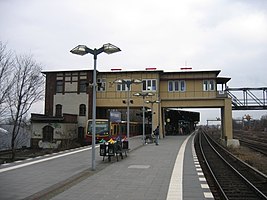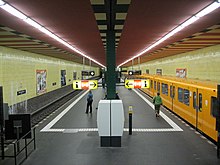Berlin-Tempelhof train station
| Berlin-Tempelhof | |
|---|---|
|
The Tempelhof S-Bahn station with the bridge signal box TF / Tr
|
|
| Data | |
| Operating point type | Breakpoint |
| Platform tracks | 2 |
| abbreviation | BTF (freight yard) BTHF (S-Bahn station) |
| IBNR | 8089090 |
| Price range | 4th |
| opening | January 1, 1872 |
| Website URL | sbahn.berlin |
| Profile on Bahnhof.de | Berlin-Tempelhof |
| location | |
| City / municipality | Berlin |
| Place / district | Tempelhof |
| country | Berlin |
| Country | Germany |
| Coordinates | 52 ° 28 '15 " N , 13 ° 23' 7" E |
| Railway lines | |
|
|
| Railway stations in Berlin | |
The Berlin-Tempelhof station is a transfer station in the Berlin district of Tempelhof . The S-Bahn station of the southern ring line is located on a railway embankment at the intersection of Tempelhofer Damm and federal highway 100 , about one kilometer south of the reception hall of Tempelhof Airport . The subway line 6 , which runs in north-south direction, crosses the Ringbahn underground here , so that a subway station was built at this point.
history
The first above-ground station was built with the construction of the Ringbahn in 1871. Originally it was located a little further west of today's station, but was moved to Tempelhofer Damm (then: Berliner Straße ) in 1895 to use it as a base for the Guard at the time. Train battalions to be better connected to the rail network. The Ringbahnhof was given a platform roof with cast-iron pillars of the Wannseebahn design.
Around 1905 a bridge signal box was built at the western end of the ring platform, which initially housed the TF signal box for the eastern exit of the freight station. Around 1928 the bridge signal box was expanded to make room for the signal box Tr for the eastern exit of the S-Bahn workshop. This bridge signal box also had a truss bridge over the tracks of the freight station, on which form signals were placed.
In 1928 the passenger tracks of the Ringbahn were electrified and in 1930 incorporated into the system of the Berlin S-Bahn. In this context, a rectifier plant, the Papestrasse S-Bahn depot, the Tat signal box at the western exit of the S-Bahn depot and a replacement for the Twt signal box at the western exit of the freight station were built in the immediate vicinity based on designs by Richard Brademann .
At the same time, Tempelhof received an underground connection with the extension of today's U6 line to the south. On December 22nd, 1929, a subway station was opened under Tempelhofer Damm south of the Ringbahn, with which, for the first time in Berlin, a direct transfer option between S-Bahn and U-Bahn was created in a shared access structure. The Tempelhof subway station (Südring) and the access structure were designed by the architect Alfred Grenander and were the model for similar examples such as B. at the train station Berlin-Neukölln .
After the Wall was built in 1961, a protest against the S-Bahn boycott took place in West Berlin , which was intended to put pressure on the GDR government, which controlled the Berlin S-Bahn network via the Deutsche Reichsbahn . This led to an extremely sharp drop in the number of passengers on the S-Bahn. After a strike by the West Berlin S-Bahn workers, a large number of S-Bahn lines in the territory were shut down as a result. The West Berlin part of the Ringbahn - and with it the Tempelhof S-Bahn station - was taken out of service in September 1980. The underground station remained in operation, but without the addition Südring in its name.
Only after German reunification was passenger transport gradually reactivated on the Berlin S-Bahn ring. However, the Senate of the time had already drawn up plans for this before the fall of the Berlin Wall. The Tempelhof S-Bahn station was reopened on December 17, 1993 with the reopening of the Baumschulenweg - Westend ring line and has since been a transfer station between the S-Bahn and U-Bahn.
At the S-Bahn platform, the train driver handles the train using the driver's cab monitor (ZAT-FM).
The restoration of the northeastern access from Tempelhof underground station to Tempelhofer Feld , which has been accessible to the public again since May 2010, has been ordered by the State of Berlin and is expected to take place by 2020. An additional exit is also planned for the S-Bahn platform on the east side of Tempelhofer Damm. For this purpose - together with the upcoming renovation of the railway bridges - a pedestrian overpass is to be built on the northern track. An implementation date has not yet been set.
Connection
The station is served by the S41, S42, S45 and S46 lines on the Ringbahn and the U6 line of the subway. It is possible to change to the bus network of the Berliner Verkehrsbetriebe.
Freight depot
The freight tracks of the Ringbahn run south of the S-Bahn station. This is where the Tempelhof freight yard begins and extends west to the junction with the Dresden Railway at Alboinstrasse. The signal bridge of the TF signal box on its eastern head was striking, and was characterized by a rare combination of light and shape signals.
In the course of the re-commissioning of the freight tracks on the Südring between Tempelhof and Halensee in 2016, the Tempelhof freight yard was connected to an electronic interlocking and equipped with new Ks signals . At the same time, the track plan has been simplified by giving up a few side tracks. The Tempelhof signal box (TF) and the signal bridge went out of operation in August 2016, after which the signal bridge was demolished.
Web links
- BVG map of the station (PDF; 37 kB)
- Tempelhof S-Bahn station on stadtschnellbahn-berlin.de
- S-Bahnbetriebswerk Papestrasse on history and stories about the Berlin S-Bahn with an aerial photo of the Tempelhof freight station
Individual evidence
- ↑ Station price list 2020. In: Deutsche Bahn. Deutsche Bahn, January 1, 2020, accessed on July 11, 2020 .
- ↑ News in brief - S-Bahn . In: Berliner Verkehrsblätter . September 2014, p. 179 .
- ↑ Printed matter 17/18610. (PDF) Berlin House of Representatives, June 10, 2016, accessed on June 28, 2016 .
- ↑ The construction of further exits at S-Bahn stations is hardly progressing. In: Der Tagesspiegel . April 24, 2017. Retrieved April 25, 2017 .


